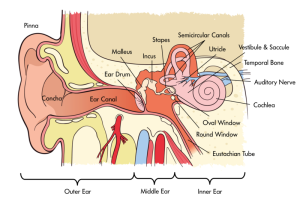3.4 Hearing (Audition)

Where our vision sense is designed to transduce light information, our hearing sense is designed to extract information from vibrations in the air (sound waves). People are capable of getting a large amount of information from the basic qualities of sound waves. The amplitude (or intensity) of a sound wave codes for the loudness of a stimulus; higher amplitude sound waves result in louder sounds. The pitch of a stimulus is coded in the frequency of a sound wave; higher frequency sounds are higher pitched. Pitch variations over time provide the basis of melody for most music, and pitch contours provide language cues (and meaning in the case of tone languages). We can also gauge the quality, or timbre, of a sound by the complexity of the sound wave – this often relies on the onset, decay, and overtones (layers of harmonics/frequencies) present. This allows us to tell the difference between bright and dull sounds as well as natural and synthesized instruments (Välimäki & Takala, 1996).
For us to sense sound waves from our environment they must reach our inner ear. Lucky for us, we have evolved tools that allow those waves to be funneled and amplified during this journey. Initially, sound waves are funneled by your pinna (the external part of your ear that you can actually see) into your auditory canal (the hole you stick Q-tips into despite the box advising against it). During their journey, sound waves eventually reach a thin, stretched membrane called the tympanic membrane (eardrum), which vibrates against the three smallest bones in the body—the malleus (hammer), the incus (anvil), and the stapes (stirrup)—collectively called the ossicles. Both the tympanic membrane and the ossicles amplify the sound waves before they enter the fluid-filled cochlea, a snail-shell-like bone structure containing cilia (auditory hair cells) arranged on the basilar membrane (see the below image) according to the frequency to which they respond (called tonotopic organization). Young humans can normally detect sounds between 20 Hz and 20 kHz, though as we age, we lose the ability to detect the higher frequencies. It is inside the cochlea that transduction occurs and sound waves are converted into an electrical message.
After being processed by auditory hair cells, electrical signals are sent through the cochlear nerve (a division of the vestibulocochlear nerve) to the thalamus, and then the primary auditory cortex of the temporal lobe. Interestingly, the tonotopic organization of the cochlea is maintained in this area of the cortex (Merzenich, Knight, & Roth, 1975; Romani, Williamson, & Kaufman, 1982). However, the role of the primary auditory cortex in processing the wide range of features of sound is still being explored (Walker, Bizley, & Schnupp, 2011).


